Ever done double blind ABX testing? You do know that the brain is easily fooled by expectation bias, very much so with audio? Check out the McGurk effect if you want a visceral demonstration of how human hearing is deeply fallible to suggestion and definitely cannot be trusted without fully blinded testing.The difference between the stock opamp and the burson is immense, how could someone not notice? it's like 120hz(not even 144hz) vs 240hz, only a deaf or an old person couldn't notice such big difference.
If you take a device and replace a component, and then listen to it again you are also having to rely on memory (as you can't
AB-switch with the old component sitting on the bench). Quality auditory memory lasts about 7 seconds or so.
Come on let's be serious, stock vs burson is easily audible
if you are joking it's fine but with ur experience you have to notice, even novice listeners will notice the difference, it's just too obvious.
Thank you everyone for your input but i'm going to test it myself, the lowest noise one opa1612/1611 and the bursons.
Adason seems like the most reliable compared to my direct experience.
I can't talk about you because i didn't test personally cbdb but i'll try your suggestion and pick the one i prefer.
if you are joking it's fine but with ur experience you have to notice, even novice listeners will notice the difference, it's just too obvious.
Thank you everyone for your input but i'm going to test it myself, the lowest noise one opa1612/1611 and the bursons.
Adason seems like the most reliable compared to my direct experience.
I can't talk about you because i didn't test personally cbdb but i'll try your suggestion and pick the one i prefer.
Last edited:
Can't waith to see non effect boxes of yours.
Dick & Roger's Sound Studio | Studios
Services & Facilities — Post Modern Sound
Sharpe sounds mixing and recording studios — SSS/TV
Etc.
Absolutely 100% serious and I'll ask again do you use double-blind testing for these comparisons?Come on let's be serious, stock vs burson is easily audible
if you are joking it's fine but with ur experience you have to notice, even novice listeners will notice the difference, it's just too obvious.
Absolutely 100% serious and I'll ask again do you use double-blind testing for these comparisons?
Because if you don't you are just fooling yourself.
Your ears are not half as good as you think they are.
Double-blind is the way to go, but...
Hear me out. I am scientist, working in pharma industry for two decades, being in formulation group, close to fill finish and clinical trials. While not in clinical directly, I know about clinical trials and the need for double-blinding of clinical trials. We know well about the effect of placebo. All well documented. There was even one guy who knew that faith can heal you, he even walked on the water.
Long time ago, when me and my buddies went to Mt. Whitney, after the successful trip, had one more extra day in LA, we celebrated. Did bbq, drink some beer. We went to total vine&more, and got as many types of czech beer we could find, being originally from that country. We did tasting, comparison, we had fun. We had about seven types of beer and differences were obvious. Each of us had its favorite, we joked about being able to recognize it from other. At one point, someone suggested to do blind testing. Long story short, blindly we were not able to identify each just by taste.
Otherwise sipping openly we all could differentiate.
What is going on?
One could say that because of double-blind, we proved that there were no differences in all the beers tested. While the differences were obvious.
Or something else is in play.
Why am I going on the tangent like this is that I do have a problem with double-blind experiment. While its is absolutely necessary in clinical trials, I do not use it in audio.
I am partial to sauvignon blanc, have tasted many, have my favorites, even have blog about it (since I have poor memory and want to avoid buying bad vine again). Each vine tastes differently, I have never encountered two sauvignons from two different vinaries to taste the same. Yet I would fail miserably in double-blind tasting competition.
My beef with double-blind testing is that it shifts attention from the subject to the tester. The listener is being evaluated if he recognizes differences, being amp, or speakers, or anything else. Rather than judging how much is one enjoying the sound.
Plus, quick switch between A, B or X has nothing to do with long term compatibility. If you ask kid to take a bite from bread or cake, they will prefer cake.
Similarly in carousel full or rotating speakers where one can listen few minutes to each speaker, one can select speaker with lifter highs and so on. Such speaker may induce fatigue in long term. Not compatible with long term listening.
So, yes, long post, nothing against double-blind testing, important in some fields, but audio, I am not so sure. I listen with one amp for a week or more, then replace it with new amp, and listen again for a week. Listening long term, all sorts of music. Then I decide which stays in the system. Do I require to prove to someone that I will be able to differentiate these two amps in double-blind test? Absolutely not.
But every one is different, and that's fine with me.
Cheers!
Hear me out. I am scientist, working in pharma industry for two decades, being in formulation group, close to fill finish and clinical trials. While not in clinical directly, I know about clinical trials and the need for double-blinding of clinical trials. We know well about the effect of placebo. All well documented. There was even one guy who knew that faith can heal you, he even walked on the water.
Long time ago, when me and my buddies went to Mt. Whitney, after the successful trip, had one more extra day in LA, we celebrated. Did bbq, drink some beer. We went to total vine&more, and got as many types of czech beer we could find, being originally from that country. We did tasting, comparison, we had fun. We had about seven types of beer and differences were obvious. Each of us had its favorite, we joked about being able to recognize it from other. At one point, someone suggested to do blind testing. Long story short, blindly we were not able to identify each just by taste.
Otherwise sipping openly we all could differentiate.
What is going on?
One could say that because of double-blind, we proved that there were no differences in all the beers tested. While the differences were obvious.
Or something else is in play.
Why am I going on the tangent like this is that I do have a problem with double-blind experiment. While its is absolutely necessary in clinical trials, I do not use it in audio.
I am partial to sauvignon blanc, have tasted many, have my favorites, even have blog about it (since I have poor memory and want to avoid buying bad vine again). Each vine tastes differently, I have never encountered two sauvignons from two different vinaries to taste the same. Yet I would fail miserably in double-blind tasting competition.
My beef with double-blind testing is that it shifts attention from the subject to the tester. The listener is being evaluated if he recognizes differences, being amp, or speakers, or anything else. Rather than judging how much is one enjoying the sound.
Plus, quick switch between A, B or X has nothing to do with long term compatibility. If you ask kid to take a bite from bread or cake, they will prefer cake.
Similarly in carousel full or rotating speakers where one can listen few minutes to each speaker, one can select speaker with lifter highs and so on. Such speaker may induce fatigue in long term. Not compatible with long term listening.
So, yes, long post, nothing against double-blind testing, important in some fields, but audio, I am not so sure. I listen with one amp for a week or more, then replace it with new amp, and listen again for a week. Listening long term, all sorts of music. Then I decide which stays in the system. Do I require to prove to someone that I will be able to differentiate these two amps in double-blind test? Absolutely not.
But every one is different, and that's fine with me.
Cheers!
Last edited:
@adason
The rapid change of the test OPAs alone is a problem, because humans only have a very short hearing memory when it comes to the finest nuances.
Thus, you would need two completely identical amplifiers that are also tested for equality. They also have to be adjusted volume-wise meticulously the same.
Then you would have the possibility to switch quickly and that would even be a condition for an ABX test.
Almost no one has as a HiFi hobbyist two identical amplifiers lying around. It remains therefore with the successive listening and the OPAs one exchanges as a rule also itself - not even in this respect it is a blind test.
The rapid change of the test OPAs alone is a problem, because humans only have a very short hearing memory when it comes to the finest nuances.
Thus, you would need two completely identical amplifiers that are also tested for equality. They also have to be adjusted volume-wise meticulously the same.
Then you would have the possibility to switch quickly and that would even be a condition for an ABX test.
Almost no one has as a HiFi hobbyist two identical amplifiers lying around. It remains therefore with the successive listening and the OPAs one exchanges as a rule also itself - not even in this respect it is a blind test.
......
Now i'm really curious about the OPA1611/1612 but i'm still waiting someone that confirms they are a good choice over the OPA1656 (only for dual)
Gives similar OPAs look like as OPA1611/1612 - but with FETs on input?
humans only have a very short hearing memory when it comes to the finest nuances.
This silly old dogma cannot be applied to anyone with pretensions to be an audiophile. Training the aural memory is perhaps the most essential part of the hobby.
My Infinity RSIIb speakers come with a "necessary evil" low frequency EQ box with two single and two dual opamps. I run the speakers with DHT SET amps and a DHT 01A preamp and DAC, and have tried many different opamps in the EQ box to mlnimize its negative effect on the sound. For years, nothing beat OPA827, until I tried the V6 Vivid. The Vivid is hands down the best sounding in that application, in my system. YMMV.
PS: I managed to nestle a 0.1uF C0G cap in the included dip-8 adapter to bypass the +/- power pins by Dremeling a small indentation in the bottom of the V6 case. See pics.
PS: I managed to nestle a 0.1uF C0G cap in the included dip-8 adapter to bypass the +/- power pins by Dremeling a small indentation in the bottom of the V6 case. See pics.
Attachments
thank you very much for the pictures and the little tip Magz! could you please link the cap ur using on mouser or digikey?
Another question, if could i use a bigger one (i have the necessary space) would you suggest a film cap? can you please provide some mouser links to it?
I'm relatively new to this world but i'm really trying to understand as much as possible in a short time, some tips are always appreciated to pick the right road and improve things.
Another question, if could i use a bigger one (i have the necessary space) would you suggest a film cap? can you please provide some mouser links to it?
I'm relatively new to this world but i'm really trying to understand as much as possible in a short time, some tips are always appreciated to pick the right road and improve things.
thank you very much for the pictures and the little tip Magz! could you please link the cap ur using on mouser or digikey?
Another question, if could i use a bigger one (i have the necessary space) would you suggest a film cap? can you please provide some mouser links to it?
I'm relatively new to this world but i'm really trying to understand as much as possible in a short time, some tips are always appreciated to pick the right road and improve things.
I'm currently in Europe but when I get home at the end of the week I can post the Digikey part#.
There really wasn't space in my application to add a larger cap so I went with the .1uF C0G; you can use whatever will fit in your system. Film caps work well, too. Any polypropylene film and foil should work. I can also post a part # for that when I get back, but Burson had been recommending and selling 0.1uF Wima MKP caps for their previous opamps.
WIMA MKP 0.1uF X 8 - Burson Audio
Last edited:
My rail-bypass caps near DIP socket
Evox Rifa PHE 450 0,1 uF
and bypassed the Evox Rifa PHE 450 100nF (C2, C3) with WIMA FKP2 10nF/63V
In front Evox Rifa PHE 450 0,1 uF are hidden from the Borson amps
Evox Rifa PHE 450 0,1 uF
and bypassed the Evox Rifa PHE 450 100nF (C2, C3) with WIMA FKP2 10nF/63V
In front Evox Rifa PHE 450 0,1 uF are hidden from the Borson amps
Attachments
- Home
- Amplifiers
- Chip Amps
- Burson Vivid V6 ~ Shell




